| Mr.
Gary Reber, Editor-In-Chief and Publisher of Widescreen Review
magazine, in his presentation on "The Future Of Prerecorded
HD Formats," will cover the origins and technical elements
of the JVC D-VHS® D-Theater™ platform, the JVC-developed
D-Theater copy protection encryption scheme, studio support, and
the availability of D-Theater titles. Mr. Reber will also cover
the development of competing HD-DVD optical disk technologies
and the challenges ahead, related to copy protection encryption
schemes and protected A/V interfaces necessary for prerecorded
high-value, high profile content production.
Introduction
The first working device for producing electrical signals for
television transmission was a mechanical scanning system built
by Paul Nipko in 1884. Later Valdimer Zworykin immigrated to the
United States from Russia to develop an all-electronic television
system. It was only after a technical paper given by Zworykin
in 1929 that another Russian immigrant and then Vice President
of the Radio Corporation of America (RCA), David Sarnoff, was
inspired enough to create a business. Sarnoff provided Zworykin
with the laboratory resources to realize the dream and then in
1939 announced to the world at the New York World’s Fair
that the beginning of a new era—an era where moving images
and sound would be in every home—was at hand.
Sarnoff controlled both the manufacturing of television sets through
RCA and the transmission signals via the National Broadcast Corporation
(NBC). Sarnoff clearly understood that only with a combination
in the marketplace of consumer TV sets and TV signals could the
industry be born. This scenario of hardware supported with software
has been the basis of numerous successes in consumer electronics.
The most successful launch was the DVD platform.
In 1996, fifty-seven years after the New York World’s Fair,
the Victor Company of Japan introduced a high-definition VCR platform
that set the highest standard for consumer use recording and playback.
The D-VHS® format was introduced a year before the DVD-Video
format was launched. Kazuno Kohda is credited with the invention
of Digital or Data-VHS.
The D-VHS format sets the highest standard thus far for HD picture
quality, and as well, sound quality in a home video format. But
HD-DVD is clearly on the horizon and will inevitably become the
preference of consumers for prerecorded high-definition content.
I will address the possible forms that HD-DVD will take and whether
HD-DVD will equal or exceed the performance standard set by D-VHS.
In 1992, I founded Widescreen Review as a home theatre enthusiast
magazine with the intent to educate and serve as a technical resource
that explored "the best that it can be" in a home theatre
movie experience. Widescreen Review is a magazine with no vested
interest in any technology, nor egotistical interest in a particular
product technology. Yet Widescreen Review has been criticized
by some people, and others in the media, who think that we have
posed D-VHS as a competitor to HD-DVD, or even the existing DVD
format. This is absolutely not true. As an enthusiast publication,
we are only interested in "the best that it can be,"
regardless of technology or manufacturer, or price, and appreciate
any accomplishment that improves the picture and sound experience.
Experience has taught me that by supporting "the best that
it can be" in the magazine, the bar for excellence raises
across the board, and often results in better performance in products
that are far less expensive down the road.
We brought the D-VHS HD platform to the attention of our enthusiast
readers with our recent filled-to-capacity weekend D-Theater Movie
Festivals™. We premiered to enthusiast and leading industry
figures the extraordinary dimensionality and resolution that the
D-VHS D-Theater™ platform delivers as an "HD-plus"
home theatre experience, far exceeding the performance capabilities
of the very best DVDs, and even ATSC-standard (American Television
Standards Committee) HDTV over-the-air and satellite-delivered
broadcasts.
On November 28, 2002, I delivered a presentation on D-VHS D-Theater
to the International Digital Cinematography Conference on Production
and Distribution held in Moscow. In that presentation, I covered
the origins of the D-VHS format, the technical elements that constitute
the format, the JVC-developed D-Theater copy protection encryption
scheme, studio support, and the availability of D-Theater titles.
For the benefit of this audience, I will cover those topics, as
well as the development of various HD-DVD technologies competing
to become the single-format optical disk standard.
D-VHS was developed in order to meet the recording requirements
of digital broadcasts while ensuring that the existing VHS video
images that have accumulated thus far will remain accessible and
will not become obsolete.
In the 21st century, not only will TV broadcasts and cinema exhibition
go digital, but also a wide variety of information will be transmitted
as digital signals (bit stream data), and a household appliance
that can record and store information will become necessary.
While tape media has served as an excellent delivery medium, since
the advent of optical data storage, commercially successful in
the form of Compact Discs (CDs) for audio and software distribution
and Digital Versatile Discs (DVDs) for video distribution, tape
has become less desirable as the preferred consumer storage medium.
Companies involved in future optical data technologies are focused
on the next generation of optical data storage, which promises
HD digital home theatre recording and HDTV distribution. In terms
of specific optical disk technologies, however, there are distinguishing
differences, which determine the volume of data to be recorded,
and thus, impact the quality of video and audio.
What follows is a description of several technical aspects associated
with D-VHS and optical disk technologies.
Table I displays a comparison of D-VHS and optical disk technologies
in terms of several parameters. Three next-generation optical
disk technologies are listed. They are the HD-DVD-9 (a Warner
Bros. technology now being developed in the DVD Forum, the standards
body for the DVD platform), the Advanced Optical Disk (developed
by Toshiba and NEC), and the Blu-ray Disk (now called BD, as developed
by a consortium of nine consumer electronics companies—Hitachi,
LG, Matsushita, Pioneer, Philips, Samsung, Sharp, Sony, and Thomson),
which exhibits parameters similar to the abandoned Digital Video
Recorder (DVR). All three next-generation optical disk technologies
have the potential to become commercially successful in terms
of distributing HDTV. The Advanced Optical Disk and Blu-ray Disk
also have the potential for recording HDTV.
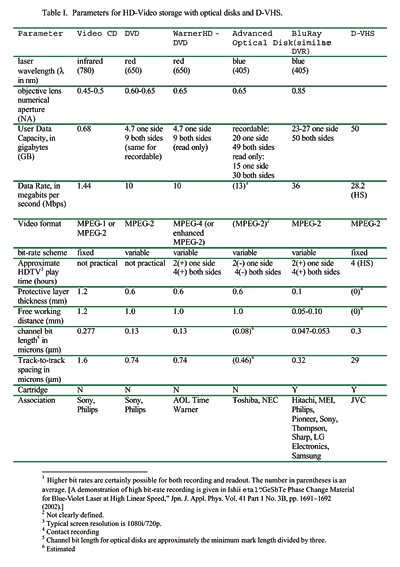
D-VHS
Among the various types of storage media, D-VHS tape media has
the advantage of removable high-storage capacity (50 GB). Even
next-generation optical disks can only store 15 to 27 GB (gigabytes)
of data on a single side, which is only about half that of D-VHS.
As previously stated, the D-VHS format was launched by JVC, the
developer of VHS, in 1996. The format features full HD record
and playback capability, and can decode D-VHS video recorded in
the 18 ATSC digital video formats. D-VHS shares the same form
factor tapes as standard VHS. The format is backward record and
playback compatible with Super-VHS and VHS.
D-VHS delivers an incredible 28.2 megabits per second (Mbps) bit
rate. This is a substantially higher data rate than the 19.3 Mbps
ATSC HDTV standard bit rate for over-the-air broadcast HDTV in
the United States, and far exceeds the 4.5 Mbps DVD-Video average
data transfer rate for a two-hour movie. As with the ATSC and
DVD-Video systems, the format uses MPEG-2 compression. Because
of D-VHS’s 28.2 data rate, HD ASTC broadcasts can be recorded
with no additional compression, thus capturing 100 percent of
the broadcast signal quality.
D-VHS’s information density is 1920 x 1080 versus DVD-Video
standard-definition (SD) 720 x 480. The format supports up to
50 GB of storage capacity. Such capacity supports up to four (4)
hours of HD recording at 28.2 Mbps and 16 hours of SD (DVD-Video
quality) recording at 6 Mbps, or eight (8) hours at 14.1 Mbps.
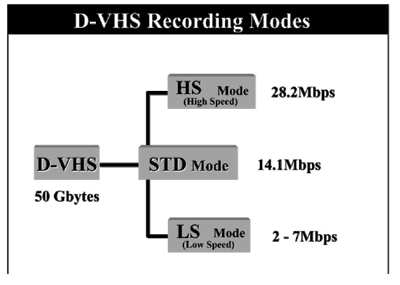
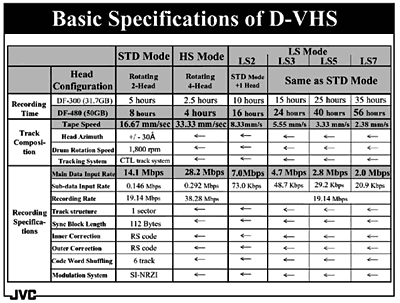
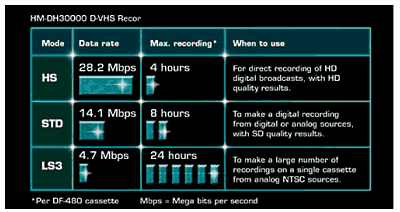
The
D-VHS format adopts IEEE 1394 as the digital input/output interface
(also referred to as FireWire® or iLink®) incorporating
DTCP or Digital Transmission Content Protection (also known as
5-C) copy protection technology.
JVC’s first generation D-VHS D-Theater VCR, the HM-DH30000U,
will output MPEG digital video from its IEEE 1394 interface (four-pin
terminal), but only when that video is not copy-protected. Digital
video from DVDs that are not copy protected can be recorded via
the DVD analog video and audio outputs using the HM-DH30000U on-board
A/D converter and MPEG encoder, but most DVDs are copy-protected.
The JVC HM-DH30000U features, in addition to IEEE 1394, an analog
HDTV video output compatible with the YPbPr input included on
most high-definition displays and will output YPbPr analog component
video signals in the 1080i (interlaced), 720p (progressive), 480p,
or 480i formats. The format and the JVC VCR are also capable of
outputting 1080p. The platform’s supporting studios and
JVC are working on the 1080p-mastering interface. It is the intent
of the studios and JVC to eventually release D-Theater-encrypted
movies in 1080p.
The D-VHS D-Theater platform is Dolby® Digital 5.1-capable
in playback of prerecorded D-VHS and D-Theater content up to the
full 640 kilobits per second (kbps) data rate. When recording
through the IEEE 1394 interface, the data rate of the source Dolby
Digital bit stream will be recorded.
With respect to DTS®, there is a caveat—JVC is completing
work on their DTS Digital Surround™ encoder so that future
D-Theater titles can be encoded in the full data-rate DTS bit
stream. The supporting studios intend to release D-Theater titles
with a DTS bit stream.
At the 2003 International Consumer Electronics Show (CES) held
in early January in Las Vegas, Nevada, JVC showed a prototype
HM-DH40000U D-VHS D-Theater HD VCR, which will likely be introduced
in the fourth quarter of 2003, perhaps at the Custom Electronic
Design & Installation Association (CEDIA) Expo in September.
This unit should incorporate DTS, but no specific information
was provided by JVC to confirm such or to provide information
on other features, including A/V interfaces.
At the CES, Marantz showed a D-VHS D-Theater HD VCR, Model MV8300,
which is scheduled for release in March 2003. This VCR is based
on the JVC HM-DH3000U’s features and does not incorporate
DTS.
In order to secure the support of Hollywood studios to release
their movies on the format, JVC developed D-Theater-encrypted
copy protection. This extremely robust encryption algorithm was
introduced in 2001. Following extensive testing by the studios,
the home entertainment divisions of four studios—Artisan
Entertainment, DreamWorks Home Entertainment, 20th Century Fox
Home Entertainment, and Universal Studios Home Video—joined
with JVC to support the new D-VHS D-Theater software platform
for high-definition copyrighted prerecorded content. The studios
are satisfied that the D-Theater encryption scheme provides a
secure level of protection to prevent the unauthorized duplication
of their movies and other high-value prerecorded content. The
support of these major content providers marks the next phase
in the acceptance of high-definition as the new standard for home
entertainment and television.
As of February 25, there are 49 prerecorded titles now available—34
studio titles D-Theater encrypted and 24 HDNet D-VHS titles without
D-Theater encryption. HDNet is a HD channel carried by the DirecTV
satellite network.
All of the D-Theater HD tapes are mastered in the 28.2 Mbps mode,
a substantially higher data rate than the ATSC standard 19.3 Mbps
for HDTV, so D-Theater movies can deliver even higher quality
images than HDTV broadcasts. In fact, some terrestrial and satellite
broadcasts do not even use the full ASTC bit rate.
The first day-and-date D-Theater title to be released simultaneously
with the DVD-Video and VHS release was 20th Century Fox Home Entertainment’s
Ice Age. The release date was November 26. Not only was this the
first day-and-date D-Theater title, but Fox’s $180 million
smash hit also features the first "Special Edition"
on this new HD format, boasting an all-new, exclusively produced
five-minute CGI animated short, Scrat’s Missing Adventure.
Continuing their support of new high-definition technology, Artisan
Home Entertainment and Universal Studios Home Video have announced
plans to roll out nine new titles in the D-VHS D-Theater format
in the first two quarters of 2003. During this time we can expect
more D-Theater day-and-date titles with DVD.
When the provision for D-Theater was introduced in 2001, JVC made
D-Theater a part of D-VHS licensing. Still, there is at present
only two D-VHS VCRs marketed in North America with the D-Theater
feature—JVC’s HM-DH30000U and Marantz’s MV8300,
which was introduced at the 2003 CES. Mitsubishi, which markets
another D-VHS VCR in North America, chose not to license D-Theater,
even though without the D-Theater feature prerecorded movies released
by studios will not play back. The D-Theater feature is licensed
for use only in North America at the present time.
The D-Theater feature adds chapter search, audio selection, running
audio commentary, alternate foreign languages, and closed-captioning
to the standard D-VHS feature set. While these features are impressive
for a VCR, other interactive features found on DVD are not possible
on the D-VHS D-Theater platform.
Why Support D-VHS?
The compelling reason to support the D-VHS D-Theater platform
is the attraction of prerecorded HD movies. The other compelling
reasons to support the platform are the capability to record HD,
archival of content long-term, and compatibility with legacy VHS
software.
Prerecorded movies are available now! I made the decision to support
Widescreen Review’s readership, which I knew would embrace
this platform, with a shopping service so they could purchase
D-VHS and D-Theater titles directly from www.WidescreenReview.com
and our subsidiary Web site—www.DVHSMovieGuide.com.
Looking back over the past twelve years of Widescreen Review’s
existence, I felt that the D-VHS D-Theater platform was a significant
event in the history of imaging science. I have been a proponent
of true high-definition video since the inception of the technology
and extensively covered the H/DTV debate amongst the technologists,
broadcasters, Federal Communication Commission (FCC), and the
Consumer Electronics Association (CEA). Thus, I have been deeply
involved in the issues surrounding the transition from analog
to digital broadcast since founding the magazine. While the issues,
with respect to HDTV in the United States, are still unresolved
and there is much to write about, I think it is important to appreciate
that the D-VHS format sets the highest standard thus far for HD
picture quality and is playing an integral role in the transition
to HDTV.
As a production tool, the D-VHS format is a cost-effective medium
for viewing HD dailies and other work. Blank tapes cost either
$15 or $25, depending on storage capacity. Studios like the medium
because of its full content security via D-Theater encryption.
The presentation quality is equal to that of d-cinema screenings
of motion pictures. Picture performance rivals the D-5 digital
video studio master, even at 28.2 Mbps versus D-5’s 375
Mbps. We performed extensive A/B comparisons at the Widescreen
Review facilities using D-5 clones and D-Theater versions of several
Universal Studios titles in our Reference Holosonic™ Spherical
Surround™ Home Theatre Laboratory with our state-of-the-art
Runco and Sony 9-inch CRT projection systems and Stewart Filmscreen
(see Issue 60, May 2002 or WSR’s HDVideo Special Edition,
Fall/Winter 2002/2003). The two sources were virtually indistinguishable.
We concluded: "D-VHS is D-5, slightly softer!"
It’s more than HDTV.
The D-VHS D-Theater platform isn’t only about HDTV. The
platform provides standard-definition digital recording quality
that is far superior to anything available from an analog VCR.
For those who keep a library of programming from satellite or
terrestrial broadcasts, switching to digital tape will greatly
improve picture quality.
There simply are no other current alternatives for prerecorded
HDTV programming, and I believe competing self-interests, economic
issues, and copy protection concerns still put a prerecorded high-definition
optical disc introduction two to four years away, or more.
Even though D-VHS D-Theater is a step back in operating convenience,
it is a giant leap forward in accessible video quality and the
ability to choose what and when we watch HDTV.
HD Optical Disks
I am hopeful that an ultimate optical-based HD format will be
required to equal or surpass D-VHS performance, in order for it
to be embraced by enthusiasts. Two of the three main contenders
for the HD optical disk throne, both blue-laser-based, show promise
to meet, if not exceed the performance of D-VHS. Each has its
own combination of formats and codecs. All three variations of
HD-DVD will require new players to read the discs. The DVD Forum,
the standard-setting body for the DVD platform, is developing
the 0.6-mm bonded disk proposed by Toshiba and NEC as the basis
of its next-generation DVD standard utilizing a blue laser. This
next-generation HD-DVD, called Advanced Optical Disk, represents
a minimal extension of the current DVD format with smaller pits
and tracks but no change to the data layer depth. Although a blue
laser is needed to read the disc, video can be encoded with MPEG-2
or a new codec still to be chosen. While Toshiba and NEC jointly
proposed the Advanced Optical Disk System to the DVD Forum in
August 2002, the Blu-ray Disk or BD proponents, supporting a competing
blue-laser technology, have decided to launch their format without
the sanction of the DVD Forum, even though the nine companies
supporting the format are also members of the DVD Forum. The third
contender is the Warner Bros. proposal for an HD-DVD-9 disc, an
adaptation of the existing dual-layer DVD-9 format, requiring
no changes to the physical disc, only a new codec for the video.
In optical disk systems, disk capacity is maximized through the
use of high numerical aperture or NA and short laser wavelength.
To insure maximum contamination protection, the disk’s protective
layer should be as thick as possible. However, the combination
of thick protective layer and high NA is not easily accomplished.
High NA systems are sensitive to changes in substrate thickness
and disk tilt. Manufacturing variations create thickness non-uniformities,
which are usually a small percentage of the total disk thickness.
Motor instabilities induce tilt as the disk spins. These and other
factors cause aberrations and degrade the read-out signal. In
order to limit these effects, the disk substrate is made as thin
as possible without sacrificing contamination protection.
The most conservative optical disk technology is the Video CD
with a thick protective layer, relatively low NA, and long laser
wavelength. This produces a system with an ideal spot size of
1.6 micrometers that is not very sensitive to environmental factors
like dust and scratches. DVD technology uses a shorter wavelength
laser, higher NA optics, and a thinner protective layer. The combination
of short wavelength and higher NA produces a spot size of about
1.1 micrometers. The protective layer is thinner and thus, DVDs
are slightly more sensitive to dust and scratches than CDs. While
the higher NA reduces the focal depth, DVDs have more robust error
management. The Warner HD-DVD-9 system is exactly the same as
a DVD in terms of the optical parameters. The Advanced Optical
Disk and Blu-ray Disk systems both use a new blue laser source
that emits 0.405-micrometer light. The Advanced Optical Disk system
uses the same protective layer thickness as a DVD, and it uses
the same NA objective lens. Due to the short wavelength, the spot
size for the Advanced Optical Disk is about 0.62 micrometers.
Sensitivity to dust and scratches is about the same as a DVD.
Sensitivities to thickness variations and disk tilt are worse,
however, due to the wavelength difference. In order to increase
the capacity of the Advanced Optical Disk to 20 GB, margins like
tilt sensitivity need to be significantly improved in the Advanced
Optical Disk and player systems, as compared to DVD players. The
Blu-ray system uses both higher NA and a thinner cover layer.
The spot size is 0.48 micrometers, which is the smallest spot
size of all the technologies listed in Table I. However, because
of the high NA, the protective layer had to be made thin to limit
sensitivity to thickness variations and disk tilt. Therefore,
Blu-ray disks are sensitive to dust and scratches, and thus, in
their naked (without protective cartridge) form, are not as consumer-friendly
as the other two naked optical disk technologies.
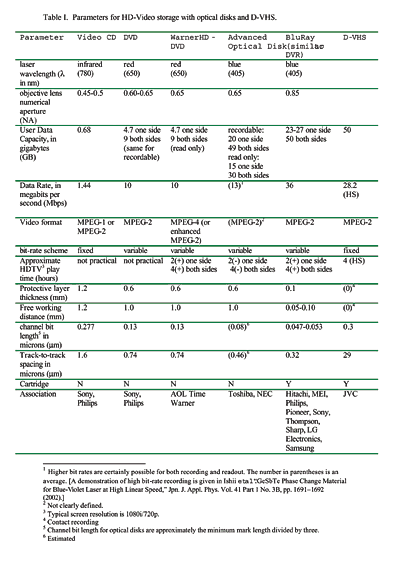
To the user, all generations of optical disks look very similar.
They all are round disks that are approximately 120 mm thick.
The CD uses a simple 1.2 mm thick substrate. Data is recorded
on only one side of the disk, through the clear 1.2 mm substrate,
which also serves as the protective layer. DVDs, Warner’s
HD-DVD-9s, and Advanced Optical Disks use a format where the layers
are separated by a thin adhesive spacer (see Figure 1B). The two
layers are fabricated before bonding at the same time as the individual
0.6 mm substrates. Like the CD, data is recorded and read through
the clear substrates. It is likely that the Warner HD-DVD-9 and
Advanced Optical Disk will also take advantage of this multiple-layer
concept. Blu-ray Disks initially will have only one layer on one
side. Next-generation BD product will probably be a two-layer
single-sided disk. Eventually, the dual-layer dual-sided disk
may be produced. Because of the thin protective layer, the Blu-ray
Disk will likely be used with a cartridge, as was demonstrated
at the 2003 CES. A cartridge-based disk system will be more expensive
to produce and cost more as a consumer prerecorded HD delivery
medium. If Blu-ray follows the development of DVD-RAM, the product
will first be released in a cartridge and then migrate to naked
disks that do not need a cartridge. The difference in the Blu-ray
Disks that do not need a cartridge is the addition of a thin,
hard protective coating. Blu-ray Disks, like DVDs and Advanced
Optical Disks utilize true error correction. The error correction
scheme in Blu-ray is designed to allow random file manipulation,
like DVD. It also includes a more robust correction scheme called
"Picket ECC" that partially counters the increased sensitivity
of Blu-ray to dust and scratches by emphasizing correction of
burst errors.
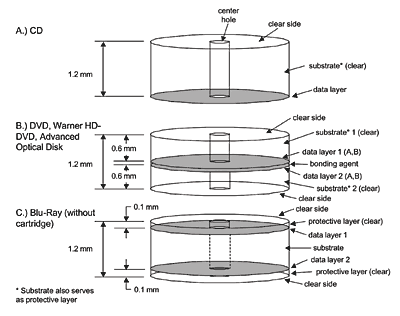
DVDs allow very efficient methods for data compression. MPEG-2
with variable bit rate allows data to be read out from the disk
as it is required, rather than supplying data at a constant rate.
Slowly-moving scenes require much less information per frame than
fast-moving scenes. Still, it is not practical to store HDTV on
DVDs with MPEG-2, as DVDs are not capable of the 13 Mbps random
data rate to support MPEG-2. The Advanced Optical Disk exhibits
acceptable data rate and reasonable user data capacity for up
to two hours of HDTV per side compressed with variable bit-rate
MPEG-2. Blu-ray has slightly higher capacity and data rate. The
two-hour playtime for HDTV with Blu-ray in Table I is really a
specification for real-time recording, which is not easily compressed
into an efficient variable-rate scheme. Blu-ray should easily
provide two hours or longer of prerecorded HDTV per side compressed
with MPEG-2.
Warner HD-DVD-9 disks play in a common DVD player that is equipped
with an advanced video operating system implementing MPEG-4, or
similar, compression. In this environment, the Warner HD-DVD-9
system may provide up to 135 minutes of HDTV per data layer at
an average 7 to 8 Mbps data rate (at 1920 x 1080 resolution with
progressive scan output). Research by Warner Bros. has shown that
90 percent of all movies would fit on an HD-DVD-9 disc offering
a data rate of 7 Mbps. At 8 Mbps, there would be sufficient space
for 80 percent of movies. At 9 Mbps, the figure is still 70 percent
of movies and at 10 Mbps, 50 percent of the film titles could
fit on a disc.
If MPEG-4 or similar compression technology is successful, it
can also be applied to the Advanced Optical Disk and Blu-ray Disk
systems. However, at this time, MPEG-4 is meant as a format only
for prerecorded video. The computation power required to process
a HDTV movie into MPEG-4 is currently beyond the consumer market,
thus the need for MPEG-2 in a record able HD-DVD format.
Comparison With D-VHS
Both D-VHS and optical disks have the potential to record and
play back at least two hours of HDTV. D-VHS in the HS mode should
record or play four hours of HDTV. Both the Advanced Optical Disk
and the Blu-ray Disk system can record and play back HDTV video.
The Warner HD-DVD-9 is for prerecorded playback only.
A basic distinction between D-VHS and optical data storage is
the bit-rate scheme. Tape is a serial, fixed bit-rate scheme at
a constant data rate. Although D-VHS has more raw data volume,
the random access capability of optical disks allows a variable
bit-rate scheme that stores video data more efficiently than the
fixed bit-rate scheme of D-VHS. Therefore, fewer gigabytes are
required to store the same length and quality of HDTV production
on optical disks.
The physical differences between D-VHS and optical disks are also
important. D-VHS has no protective layer. There is no working
distance between the readout head and the tape surface because
magnetic tape recording is a contact technology. Therefore, tape
is prone to contamination and breakage. Tape heads wear out. Tape
can also shrink. Although scratched, a simple buffing procedure
can clean an optical disk. The procedure for cleaning tape heads
is not as straightforward. Compared to rugged and reliable optical
disk technology, tape is not an effective medium to archive HDTV.
D-VHS requires a cartridge. The only optical disk technology that
has demonstrated the use of a cartridge is the Blu-ray Disk system.
The Blu-ray cartridge is used for contamination protection. Even
so, the working distance of around 0.1 mm and protective layer
thickness of 0.1 mm are large compared to the contact recording
found in D-VHS players.
The Future
Warner’s HD-DVD-9 requires the least optical system development
of the three new optical disk technologies. New decoder chips
and system architecture changes are necessary, but no changes
are required to the basic DVD optical system. It is likely that,
if accepted by the industry, the Warner HD-DVD-9 system would
be the first commercial optical disk product specifically designed
for HDTV. While Warner’s red-laser HD format could be introduced
quickly, it will probably be held until the Advanced Optical Disk
blue-laser HD format can be released at the same time. Warner
is pushing for red-laser HD-DVD-9, but only as part of a single
HD-DVD format. Just as today there are DVD-5s and DVD-9s, and
most customers don’t know or care about the difference,
there could be red-laser HD and blue-laser HD. Red-laser HD discs
would have lower capacity but would be cheaper, just like DVD-5
discs, while blue-laser HD discs would have higher capacity but
would cost more to replicate, like DVD-9s. As time goes by, the
cost difference will inevitably decrease, but for the first few
years of the format there could be a difference in replication
cost.
HD-DVD-9 is seen as complementary rather than competitive with
blue laser, and both Warner and Toshiba would like the technology
to be integrated with blue laser players. Warner’s vision
is of SD DVD-Video and HD-DVD content co-existing, so consumers
will go into stores and find both SD and HD discs and players.
While HD content will not play on SD players, HD players will
be able to read existing SD DVD-Video content and HD content because
"inside" every blue laser player will be a red laser
player.
The Advanced Optical Disk requires some significant changes to
the optical system, including the addition of a blue laser and
the associated detectors, but the technology for making disks
is very similar to existing DVD technology.
Blu-ray could be considered the "true" HD format: it
has high capacity and high data rates (up to 36 Mbps), so you
can easily get the same HD quality as D-VHS using MPEG-2. The
Blu-ray system, however, requires the most changes of the three,
including a blue laser, detector, and advanced objective lens.
Blu-ray also requires new disk and cartridge manufacturing technology,
which may be difficult to implement in a short time-frame. The
Blu-ray group is busy working independently from the DVD Forum
to get their format done. It’s possible that Blu-ray recorders
could be out in time for the December 2003 holiday season, but
it’s more likely we won’t see them until 2004, at
least in the U.S. Originally the Blu-ray group was ignoring prerecorded
movies and concentrating entirely on introducing Blu-ray as a
home recording format, but recently they realized that content
is what makes or breaks a format. (Without Hollywood movies, DVD
would be nowhere.) Work is now underway in the Blu-ray group to
define a ROM version and a specification for video navigation
to provide menus and interactivity ala DVD-Video. Even so, since
Blu-ray requires significant changes across the entire disc replication
industry, it will be some time before movies can be distributed
on prerecorded Blu-ray discs. How long, you ask? It will take
at least one year for Blu-ray to make it out of the laboratory
and probably two years to make it into homes. The first version
of Blu-ray might be for home recording only, in which case it
might take another two or three years until there’s a prerecorded
version for movies. So it could take until 2005 to 2007, perhaps
longer. Many of us wish we had HD-DVD today but do we want to
wait that long?
Content holders are likely to find HD-DVD-9 very attractive in
the early years of HD-DVD because both blue laser formats will
initially be low-volume and cost two to three times to manufacturer
compared to HD-DVD-9 discs. As with SD DVD-9, HD-DVD-9 discs are
easier to make and cost under $1.00 to produce.
As always, copy protection is lurking in the background. Copy
protection issues delayed the release of DVD by about six months
in 1996 and 1997. It could once again cause significant delays
in the release of HD-DVD, especially since studios are even more
sensitive about releasing "studio master quality" versions
of their titles. The copy protection scheme will probably be a
variation of CPPM (Copy Protection for Prerecorded Media), the
improved version of CSS (Content Scrambling System) that’s
used for DVD-Audio discs (known as CSS II). Again, any attempt
to release HD-DVD recorders before things such as copy protection
and protected A/V interface standards for HD-DVD video are finalized
means the recorders won’t be able to play HD movies. We’ve
already seen the results of this conundrum in a million or so
DVI (Digital Visual Interface) displays that can’t show
video protected with the HDCP (High-bandwidth Digital Content
Protection) encryption protocol and the next-generation HDMI (High
Definition Multimedia Interface) A/V interface and HDCP.
The upshot of all this is that there probably won’t be a
"transition" format for HD-DVD. It really isn’t
an issue of red-laser HD-DVD "competing" with blue-laser
HD-DVD, since it looks like they will be released hand-in-hand
as variations of a single HD-DVD format approved by the DVD Forum.
But there is definitely a major train wreck shaping up between
the Forum’s blue-laser HD-DVD and Blu-ray, which is especially
ironic since Blu-ray companies are all members of the DVD Forum.
The DVD Forum is expected to reach a decision, at least with respect
to HD-DVD-9, during the first half of 2003.
All three optical disk technologies will require double inventory
of prerecorded HDTV to coincide with DVD and VHS, and D-VHS D-Theater
releases. One promising other optical disk technology which does
use a backward-compatible, single-inventory approach is being
developed by Pixonics (www.pixonics.com). While I am under a non-disclosure
agreement, I can tell you that the concept involves layered encoding
for backward compatibility. This approach also is being proposed
to the DVD Forum. This has been extensively covered before in
Widescreen Review (see Issues 43, November 2000; Issue 35, November/December
1999; and Issue 34, September/October 1999), particularly in interviews
with Joe Kane and Jim Taylor, both contributing editors. The basic
idea is that instead of jumping to a completely new format that
won’t play on existing players, the SD version of video
can be encoded along with the "difference signal" created
by "subtracting" the HD version from the SD version.
The result is a video stream that could play in standard players,
while the HD enhancement layer could be read and decoded by HD
players and added to the SD base layer to create an HD signal.
The nice thing about this approach is that discs could be released
today that would play in SD on the existing 250 million DVD playback
devices worldwide, but could also provide an HD signal for future
players. Some potential disadvantages are that this approach is
probably less efficient than a pure HD approach and most attempts
to make it work have resulted in degradation of the SD signal.
In other words, in order to get really nice HD quality tomorrow,
you might have to live with lower SD quality today. How many people
are willing to make that sacrifice?
A few of the scenarios that might play out:
- Realistic case: two formats (red + blue versus Blu-ray)
- Worst case: three incompatible formats (red versus blue versus
Blu-ray)
- Really worst case: splits within the Blu-ray group resulting
in even more competing formats
- Utopian case: a single format (blue or red + blue)
The one thing we can be fairly certain of is that backward compatibility
will be preserved. Just as today’s DVD players can play
audio CDs, tomorrow’s HD-DVD players will play today’s
SD-DVDs (and audio CDs to boot). The players may have to get physically
bigger just to make room for all the little logos on the faceplate.
Customers will expect future DVD players to be able to play the
following:
CD (CD audio)
CD-R (CD audio, MP3)
CD-RW (CD audio, MP3)
DVD (DVD-Video)
DVD-R (DVD-Video)
DVD-RW (DVD-Video)
DVD+R (DVD-Video)
DVD+RW (DVD-Video)
HD-DVD-9 (red laser HD)
Blue laser HD
The player manufacturers have their work cut out for them. The
next few years of DVD development should prove most interesting.
Conclusion
In conclusion, as previously forecast in Widescreen Review past
issues, an impending format battle is imminent. Even so, already,
the D-VHS D-Theater platform is proving to satisfy current and
future HD adopters, as is evidenced by the increasingly supportive
home theatre Internet forums - www.avsforum.com
and www.hometheaterforum.com
- the sales of JVC’s HM-DH30000U and Marantz’s MV8300
VCRs and prerecorded D-Theater titles.
I certainly hope that HD-DVD meets or exceeds the specifications
of D-VHS and that a single standard, at least equal to the video
and audio performance of the D-VHS platform, arrives soon.
Still, I support D-VHS, because right now it is technically the
best video format available to the consumer in terms of picture
(and sound) quality, and rivals the picture quality of d-cinema.
I think D-VHS can be an integral part of the overall transition
to HDTV, since we’re at a point in time now where some real
tangible software is needed to demonstrate to a wider audience
the capability of HD, as well as to serve the early and current
adopters who have already invested in HD-capable displays and
are eagerly waiting for true HD-quality source material. Having
some really good HD programming from motion pictures is key in
this respect.
P.S. Special thanks to Jim Taylor and Tom Milster, both contributors
to Widescreen Review, and to Perry Sun, Managing Editor, for their
contribution to this presentation.
|